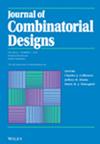Commuting Pairs in Quasigroups
IF 0.8
4区 数学
Q3 MATHEMATICS
引用次数: 0
Abstract
A quasigroup is a pair , where is a nonempty set and is a binary operation on such that for every , there exists a unique such that . Let be a quasigroup. A pair is a commuting pair of if . Recently, it has been shown that every rational number in the interval can be attained as the proportion of ordered pairs that are commuting in some quasigroup. For every positive integer , we establish the set of all integers such that there is a quasigroup of order with exactly commuting pairs. This allows us to determine, for a given rational , the spectrum of positive integers for which there is a quasigroup of order whose proportion of commuting pairs is equal to .
准群中的交换对
拟群是一对(Q,*);其中Q是一个非空集合,并且∗是一个对Q的二元操作这样对于每一个(a)b)∈q2;存在唯一的(x,y)∈q2,使得A * x = b = y * A。设(Q,*)是一个拟群。 一对(x,y)∈Q 2是的可交换对(q,如果x * y =Y * x。最近,已经证明了区间(0,(1)可以用准群中可交换的有序对的比例来表示。对于每一个正整数n,我们建立所有整数k的集合,使得存在一个n阶的拟群K个可交换对。这允许我们确定,对于给定的有理q∈(0)[1];正整数n的谱,其中有一个n阶的准群,其交换对的比例等于问 .
本文章由计算机程序翻译,如有差异,请以英文原文为准。
求助全文
约1分钟内获得全文
求助全文
来源期刊
CiteScore
1.60
自引率
14.30%
发文量
55
审稿时长
>12 weeks
期刊介绍:
The Journal of Combinatorial Designs is an international journal devoted to the timely publication of the most influential papers in the area of combinatorial design theory. All topics in design theory, and in which design theory has important applications, are covered, including:
block designs, t-designs, pairwise balanced designs and group divisible designs
Latin squares, quasigroups, and related algebras
computational methods in design theory
construction methods
applications in computer science, experimental design theory, and coding theory
graph decompositions, factorizations, and design-theoretic techniques in graph theory and extremal combinatorics
finite geometry and its relation with design theory.
algebraic aspects of design theory.
Researchers and scientists can depend on the Journal of Combinatorial Designs for the most recent developments in this rapidly growing field, and to provide a forum for both theoretical research and applications. All papers appearing in the Journal of Combinatorial Designs are carefully peer refereed.

 求助内容:
求助内容: 应助结果提醒方式:
应助结果提醒方式:


